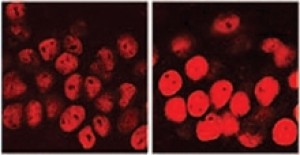Early Epigenetic Effects in Alzheimer’s Disease
Early Epigenetic Effects in Alzheimer’s Disease
Repression of certain gene activity in the brain appears to be an early event affecting people with Alzheimer’s disease, a new study found. In mouse models of Alzheimer’s disease, this blockade and its effects on memory were treatable.

HDAC2 levels (red) are higher in cells from the hippocampus of a mouse model of Alzheimer’s disease (right) than in cells from a normal mouse hippocampus (left) Image by Johannes Gräff et al, courtesy of Nature.
Alzheimer’s disease is the most common cause of dementia in older adults. It affects as many as 5.1 million Americans. A hallmark of the disease is the accumulation of a toxic protein fragment called beta-amyloid in brain nerve cells (neurons). Preventing the cognitive problems that result has been a major medical challenge.
Studies in animals have linked a process called histone acetylation in brain cells to cognitive decline. Histones are the structures around which long DNA strands are wound to make chromosomes. When histones undergo chemical modifications such as acetylation (the addition of an acetyl group), this changes how DNA is packed and thus how genes are read, or expressed. Such changes are called epigenetic modifications.
Drugs that increase histone acetylation can reverse cognitive decline in animal models. Most of these drugs target proteins called histone deacetylases (HDACs). However, exactly how histone acetylation affects cognition has been unknown. A research team led by Dr. Li-Huei Tsai at the Massachusetts Institute of Technology used mouse models of Alzheimer’s disease to investigate. Their work was partly supported by NIH’s National Institute of Neurological Disorders and Stroke (NINDS) and National Institute on Aging (NIA). The study appeared online on February 29, 2012, in Nature.
Around the time the mice began to show signs of brain cell degeneration, the researchers found, the animals had higher levels of HDAC2, but not other related HDAC proteins, in the parts of the brain involved in learning and memory. This increase in HDAC2 was linked with a decrease in the expression of neuronal genes that HDAC2 is known to regulate.
When the researchers used a gene therapy approach to reduce levels of HDAC2, they found that the technique prevented the blockade of gene expression. It also prevented learning and memory problems in the mice. It didn’t keep neurons from dying, but it did enhance the ability of remaining neurons to form new connections.
The scientists next examined HDAC2 levels in autopsied human brain tissue. The researchers found that even people in the earliest stages of Alzheimer’s disease had higher HDAC2 levels in the learning and memory regions of the brain.
Suspecting that HDAC2 is brought into play by beta-amyloid, the team exposed mouse neurons to beta-amyloid. The exposure led to more HDAC2 production. Beta-amyloid, they believe, triggers a cascade of damaging reactions that have a variety of effects, including the activation of HDAC2.
“We think that the blockade of gene expression plays a very important role in the cognitive decline associated with Alzheimer’s disease,” Tsai says. “The good news is that the blockade is potentially reversible.”
Therapies aimed at reducing beta-amyloid are now in clinical trials. Drugs targeted to HDAC2 may provide a complementary approach. The research team is now working to identify HDAC2-specific inhibitors that might be developed into drugs and moved into trials.
###
* The above story is reprinted from materials provided by National Institutes of Health (NIH)
** The National Institutes of Health (NIH) , a part of the U.S. Department of Health and Human Services, is the nation’s medical research agency—making important discoveries that improve health and save lives. The National Institutes of Health is made up of 27 different components called Institutes and Centers. Each has its own specific research agenda. All but three of these components receive their funding directly from Congress, and administrate their own budgets.




















